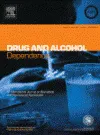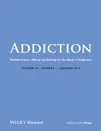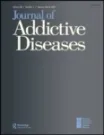 Accueil
Accueil
Détail de l'auteur
Auteur S. S. MARTINS |
Documents disponibles écrits par cet auteur (23)
 Ajouter le résultat dans votre panier Faire une suggestion Affiner la recherche
Ajouter le résultat dans votre panier Faire une suggestion Affiner la recherche
Article : Périodique
Objective: Social media and other digital technology use facilitate connection among adolescents, but also may reinforce norms and substance-related content from peers and advertisers. We use nationally representative data to examine the associa[...]
Article : Périodique
M. M. PHILBIN ; P. M. MAURO ; J. SANTAELLA-TENORIO ; C. M. MAURO ; E. N. KINNARD ; M. CERDA ; S. S. MARTINS |Background: Medical cannabis laws (MCL) have received increased attention as potential drivers of cannabis use (CU), but little work has explored how the broader policy climate, independent of MCL, may impact CU outcomes. We explored the associa[...]
Article : Périodique
IMPORTANCE: Heroin use is an urgent concern in the United States. Little is know about the course of heroin use, heroin use disorder, and associated factors. OBJECTIVE: To examine changes in the lifetime prevalence, patterns, and associated dem[...]
Article : Périodique
BACKGROUND AND AIMS: Among adolescents, risk preference and deviant behaviors are associated with marijuana use, which exhibit substantial historical trends. We examined (1) trends, (2) effect modification by sex and age, (3) associations of mar[...]
Article : Périodique
R. DANIULAITYTE ; F. R. LAMY ; M. BARRATT ; R. W. NAHHAS ; S. S. MARTINS ; E. W. BOYER ; A. SHETH ; R. G. CARLSON |Aims: The study seeks to characterize marijuana concentrate users, describe reasons and patterns of use, perceived risk, and identify predictors of daily/near daily use. Methods: An anonymous web-based survey was conducted (April-June 2016) wit[...]
Article : Périodique
B. H. HAN ; S. SHERMAN ; P. M. MAURO ; S. S. MARTINS ; J. ROTENBERG ; J. J. PALAMAR |Background and Aims: The ageing US population is providing an unprecedented population of older adults who use recreational drugs. We aimed to estimate the trends in the prevalence of past-year use of cannabis, describe the patterns and attitude[...]
Article : Périodique
F. R. LAMY ; R. DANIULAITYTE ; R. W. NAHHAS ; M. J. BARRATT ; A. G. SMITH ; A. SHETH ; S. S. MARTINS ; E. W. BOYER ; R. G. CARLSON |Background: Synthetic Cannabinoid Receptor Agonists (SCRA), also known as "K2" or "Spice," have drawn considerable attention due to their potential of abuse and harmful consequences. More research is needed to understand user experiences of SCRA[...]Nouveauté

Article : Périodique
Background and Aims: Most US states have passed medical marijuana laws (MMLs), with great variation in program regulation impacting enrollment rates. We aimed to compare changes in rates of marijuana use, heavy use and cannabis use disorder acro[...]
Article : Périodique
This study explores differences in mental health and behavioral disturbances between female gamblers versus nongamblers from a community sample of 232 female urban youth. Female adolescent recreational gambling was associated with high levels of[...]
Article : Périodique
Introduction: Cannabis is one of the most widely used psychoactive substances in the United States (U.S.). Perceived risk of use is associated with substance use; the recent debate surrounding medicalization and legalization of cannabis in the U[...]
Article : Périodique
Background: Increases in illicit pharmaceutical opioid (PO) use have been associated with risk for transition to heroin use. We identify predictors of transition to heroin use among young, illicit PO users with no history of opioid dependence or[...]
Article : Périodique
M. M. WALL ; C. MAURO ; D. S. HASIN ; K. M. KEYES ; M. CERDA ; S. S. MARTINS ; T. FENG |There is considerable interest in the effects of medical marijuana laws (MML) on marijuana use in the USA, particularly among youth. The article by Stolzenberg et al. (2015) "The effect of medical cannabis laws on juvenile cannabis use" conclude[...]
Article : Périodique
R. DANIULAITYTE ; F. R. LAMY ; G. A. SMITH ; R. W. NAHHAS ; R. G. CARLSON ; K. THIRUNARAYAN ; S. S. MARTINS ; E. W. BOYER ; A. SHETH |OBJECTIVE: Twitter data offer new possibilities for tracking health-related communications. This study is among the first to apply advanced information processing to identify geographic and content features of cannabis-related tweeting in the Un[...]
Article : Périodique
Background: In recent years, there has been an increase in emergence and use of novel psychoactive substances (NPS) in the US and worldwide. However, there is little published epidemiological survey data estimating the prevalence of use in the U[...]
Article : Périodique
This study describes sociodemographic and substance use correlates of gambling behaviors, measured among 9,481 past-year gamblers from the Canadian general population. Compared to non-problem gamblers in this study (N=8,035), the 98 problem gamb[...]




